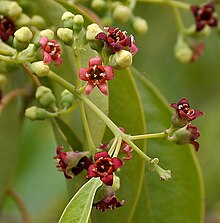Pentapetalae
| Pentapetalae | |
|---|---|

| |
| Cerasus (Rosaceae) | |
| Scientific classification | |
| Kingdom: | Plantae |
| Class: | Eudicotyledoneae
|
| (unranked): | Gunneridae |
| Clade: | Pentapetalae DE Soltis, PS Soltis & WS Judd 2007 |
| Clades and orders[1] | |
| |
In
The Pentapetalae clade is composed of the orders Berberidopsidales—including the family Aextoxicaceae[6][7]—Caryophyllales, Santalales and Saxifragales, the families Dilleniaceae and Vitaceae and all members of the clades Asteridae and Rosidae.[8]
Description
As the name of the clade suggests, the Pentapetalae have a characteristic type of flower made up of whorls of five pieces each. The perianth is formed by a sepal and a corona perfectly differentiated. The sepals are innervated by three or more vascular bundles—called leaf scars[11]—originating in the vascular system of the petiole, while the petals have only one trace. The stamen usually has twice as many pieces as the calyx and corona, which are arranged in two whorls. When the number of stamens is greater than twice the number of pieces of the perianth, they are arranged in fascicles or in a centrifugal spiral.[2][8]
The
Diversity
Dilleniales

Berberidopsidales

The flowers of
Given these differences between the two genera belonging to the same family, it has been suggested that the floral development of Berberidopsidales is a "link" in the evolution of the Gunneridae[17][18] flower, and that the floral morphology of Aextoxicon, with features such as the highly variable number of sepals and spirally arranged petals, is also compatible with this hypothesis.[19] However, the position of the Berberidopsidales in the phylogenetic tree is not congruent with it.[20]
Santalales

The order
Rosids

The
The rosids share a few morphological characteristics that distinguish them from other groups, such as the presence of
Asterids

The
The plants belonging to this clade are characterized by being herbaceous, with
Evolution and phylogeny
The age of this clade has been estimated at 113 to 116 million years.[30][31][20] The oldest macrofossils of eudicots, which unfortunately cannot be attributed to any extant group, belong to the Cretaceous-Cenomanian, just 96–94 million years old.[20]
Analyses of complete chloroplast genome sequences allowed us to resolve the relationships among the major Pentapetalae clades. Immediately after diverging from the
Several putative
The initial divergence between the Dilleniales, superrosids and superasterids must have occurred very quickly, within a period of one million years after the initial separation of the Pentapetalae from the Gunnerales. Likewise, the superrosids and superasterids show an early and very rapid divergence since the lineages that led to the Vitaceae, Saxifragales, and rosids arose within a period of only five million years, as did those that led to the appearance of the Berberidopsidales, Caryophyllales, and asterids.[20]
The following cladogram summarizes the phylogenetic relationships within the Pentapetalae clade and this clade.[36][37]
| eudicots |
| ||||||||||||||||||||||||||||||||||||||||||
The names lamiids (for euasterids I) and campanulids (for euasterids II) were suggested by Bremer et al. (2002) and later suggested fabiids (for eurosids I) and malvids (for eurosids II).
References
- ^ hdl:10654/18083.
- ^ a b c d e f g h i Stevens, P.F. 2006. Angiosperm Phylogeny Website, versión 7. http://www.mobot.org/mobot/research/apweb/ Archived 2001-12-02 at the Wayback Machine Access date: May 10, 2010.
- from the original on 2023-10-29. Retrieved 2022-11-14.
- PMID 12118410.
- .
- PMID 21653353.
- .
- ^ JSTOR 25065864.
- S2CID 4323006.
- PMID 21628193.
- ^ Gonzáles, A.M; Arbo, M.M. "Organización del cuerpo de la planta. Tema 2: Hoja. Glosario". Morfología de Plantas Vasculares (in Spanish). Argentina: Universidad Nacional del Nordeste. Archived from the original on September 29, 2010. Retrieved September 10, 2010.
- ^ Stevens, P. F. 2010. Dilleniales Archived 2019-06-09 at the Wayback Machine Angiosperm Phylogeny Website Archived 2010-02-06 at the Wayback Machine version 7 (May 2006) and updated regularly since then. Access date: 08/22/2011.
- PMID 12118410.
- .
- ^ Baillon, H. (1870). "Histoire des Plantes II". Hachette (in French). Paris: Elaeagnacées: 487–495.
- ^ Takhtajan A. 1997. Diversity and classification of flowering plants. New York: Columbia University Press
- from the original on 2022-11-07. Retrieved 2022-11-07.
- from the original on 2022-11-07. Retrieved 2022-11-07.
- ^ Ronse De Craene, Louis P. (2010). "Floral Development and Anatomy of Aextoxicon punctatum (Aextoxicaceae‐Berberidopsidales): An Enigmatic Tree at the Base of Core Eudicots". International Journal of Plant Sciences.
- ^ PMID 20176954.
- S2CID 62879334.
- ^ Moore M., Bell C., Soltis P. S., Soltis D. E.. 2008. Analysis of an 83-gene, 86-taxon plastid genome data set resolves relationships among several deep-level eudicot lineages Archived 2022-11-10 at the Wayback Machine. From Botany 2008: Botany without Borders, annual meeting of the Botanical Society of America, Vancouver, British Columbia, Canada, 97.
- ^ Nickrent, D. L.; Duff, R. J.; Colwell, A. E.; Wolfe, A. D.; Young, N. D.; Steiner, K. E.; De Pamphilis, C. W. (1998). "Molecular phylogenetic and evolutionary studies of parasitic plants". In Soltis D. E., Soltis P. S., Doyle J. J. [eds.] Kluwer, Boston, Massachusetts, EEUU.: 211–241.
- S2CID 59134940.
- from the original on 2023-11-25. Retrieved 2022-11-07.
- ISSN 0040-0262. Archived from the originalon 2023-03-10.
- ^ PMID 19223592.
- ^ JSTOR 3647306.
- ^ ISBN 978-0878938179.
- PMID 15944438.
- S2CID 1167273.
- ^ Cronquist, A (1981). An Integrated System of Classification of Flowering Plants. New York: Columbia Univ Press.
- ^ Takhtajan, A.L. (1997). Diversity and Classification of Flowering Plants. New York: Columbia Univ Press.
- from the original on 2022-06-23. Retrieved 2022-11-14.
- ^ Stevens PF. 2011 Phylogeny, version 9. Accessed September 1, 2011.
- ^ Cole, Theodor C. H.; Hilger, Hartmut H. (2013). "Angiosperm Phylogeny" (PDF). Flowering Plant Systematics. Archived from the original (PDF) on 2017-05-17. Retrieved 2022-11-07.
- S2CID 39521750.
